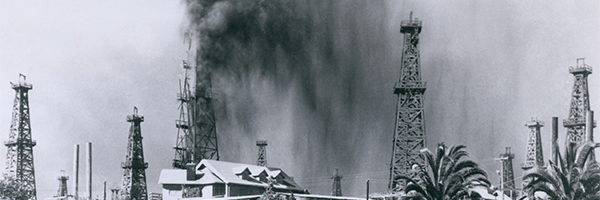PXD

July 6, 2023 | COP, Daily JAM, Dividend Income, Mid Term, PXD |
On Wednesday, July 5, Exxon Mobil (XOM) told investors that second quarter earnings could drop by 50% from earnings in the second quarter of 2022. On Thursday, July 6, shares of Exxon Mobil closed down 3.73%. Remember, we’re talking about Exxon Mobil here, one gigantic oil company. So while earnings could fall by half in the quarter, the company is still looking at quarterly earnings of $6.2 billion. Exxon’s news has implications across the energy sector.

June 20, 2023 | Daily JAM, Dividend Income, DVN, PXD, Videos |
Today’s Trend of the Week is Which is it? OK Growth in the U.S. or Not Great Growth Globally? The U.S. market is rallying and the rally even expand from the narrow nine stocks that have been driving up the indexes. The consensus is the U.S. economy will avoid a recession, the Fed will continue to pause rate hikes, and the U.S. economy as a whole is in decent shape. The problem is that the global economy presents a completely different story with asset values pricing in slowing growth. This shows up most clearly in oil prices, which have been in a downward trend. On June 13, West Texas Intermediate was selling below $70 a barrel, and Brent was down to 74.57. Goldman Sachs has cut its end-of-the-year oil price forecast by about 10%. This cut assumes continued lower demand from China and a supply glut, especially from Russia, as that country produces above agreed-upon caps in an effort to fund its war in Ukraine. If you own oil stocks right now, confirm that the ones in your portfolio can continue to make money at $70 a barrel (at least enough to cover dividends). I’d note the lowest cost source in the United States is in the Permian Basin. Companies like Pioneer National Resources and Devon Energy are focused on production from that region.

May 8, 2023 | Daily JAM, DVN, FANG, Jubak Picks, PXD, Videos |
This week’s Trend of the Week is Where is All That Oil Cash Going to Go? The likely answer: the Permian Basin and acquisitions. Oil companies like Exxon Mobil (XOM) are putting so much cash into the bank, they don’t know what to do with it. Exxon Mobil had $32.7 billion in cash in the bank. With little debt, and plenty left over after capital spending, dividends, and buybacks, the company is left with a tremendous amount of cash. Historically, extra cash could be used in oil exploration, which could take 5-15 years. In a global warming economy, that doesn’t make sense since we don’t know where oil prices and demand will be in the years ahead. The better option is acquisitions. One of the companies Exxon is rumored to be targeting is Pioneer Natural Resources (PXD) for their assets in the Permian Basin. Chevron (CVX) is in a similar position as Exxon and you can expect them to be in the market for Permian companies as well. Other Permian Basin companies that are ripe for being acquired are Devon Energy (DVN) and Diamondback Energy (FANG). I already have PXD and DVN in a portfolio in my JubakPicks Portfolio, and I’ll now be adding FANG as well.

April 7, 2023 | Daily JAM, PXD |
The Wall Street Journal reported today, Friday, April 7, that Exxon Mobil (XOM) has held preliminary, informal talks with Pioneer Natural Resources (PXD) about a possible acquisition.

April 6, 2023 | Daily JAM, DVN, GDX, GOLD, GOOG, Jubak Picks, Long Term, MSFT, PXD, SCHW |
I will add this post to the end of my post of the entire Special Report today. I’m also posting it here, however, as a stand-alone so you will get notice in your email box that Move #4 has gone up. Here’s what I posted for Move #4.

April 3, 2023 | COP, Daily JAM, EQNR, Mid Term, Morning Briefing, PXD, USO |
Today the prices of oil and oil stocks have soared. At 11:20 a.m. New York time U.S. crude benchmark West Texas Intermediate was up 5.37% to $79.73 a barrel. International benchmark Brent crude was higher by 5.24% to $84.08 a barrel. Among oil stocks, Pioneer Natural Resources (PXD) was up 3.53%; ExxonMobil (XOM ) was up 5.48%; Chevron (CVX) was up 3.73%; Equinor (EQNR) was up 5.91%; and ConocoPhillips (COP) was up 7.79% The U.S. Oil Fund (USO) was higher by 5.40%.

March 27, 2023 | COP, Daily JAM, Morning Briefing, PXD |
Oil rallied today, Monday, March 27, for the first time in, well, quite a while. Oil is likely to finish with a loss in March, for a fifth monthly drop. So today’s move, which saw West Texas Intermediate jump by almost 55, marked quite a shift in direction.

February 28, 2023 | Daily JAM, Dividend Income, Jubak Picks, PXD |
On Friday, shares of Pioneer Natural Resources (PXD) fell on a Bloomberg story reporting rumored talks between the Permian Basin oil shale producer and Appalachian natural gas producer Range Resources (RRC). On Monday shares of Pioneer rebounded as the company denied that it was in acquisition talks. The lesson? Investors really don’t want Pioneer to spend money on acquiring more assets.

February 23, 2023 | Daily JAM, Dividend Income, Jubak Picks, PXD |
Wednesday, February 22, Pioneer Natural Resources (PXD) reported better-than-expected adjusted earnings for the fourth quarter of 2022 while revenues came up short of Wall Street estimates. Revenue was still up 18% year-over-year to $5.1 billion. Fourth quarter net income nearly doubled to $1.48 billion or $5.98 share, from $763 million, or $2.97 a share, in the fourth quarter of 2021. The company declared a quarterly total dividend of $5.58/share, made up of a $1.10 base dividend and a $4.48 variable dividend. The total annualized dividend yield is approximately 11%.Which is why I’m adding the shares to my Dividend Portfolio today.

November 17, 2022 | Daily JAM, Dividend Income, Jubak Picks, PXD, Special Reports |
When I put together my Special Report: “5 Safe Dividend Stocks Paying 6% or More,” one key requirement was that the company showed a long track record of raising dividends every year and the clear potential to continue to raise dividends every year. That formula could turn a 6% annual dividend yield now into 8% or 9% or even more over the next ten years. A safe almost guaranteed 10% yield at the end of 10 years strikes me as a very attractive prospect, especially given how tough I think the financial markets are going to be over the next five years or more. (For more on that outlook see my recently revised Special Report: “Your Best Investment Strategy for the Next Five Years.”) But I realized, looking at all the high-yield stocks that didn’t make the cut for that report that the requirement for a high-probability trend of higher dividends each year for the next 10 years, that this requirement left a lot of stocks paying very attractive high dividends now on the cutting room floor. Stocks paying 8% or more got left off the list because I didn’t see a commitment at the company to continued dividend increases every year or enough growth in free cash flow to make it possible for a company to raise or maintain its dividend through the ups and downs of the business cycle. These stocks paying 8% or more were very safe bets to continue paying that yield for the next year or two. But 10 years? Too much uncertainty. Which doesn’t mean you shouldn’t own some of these stocks now. An 8% or better yield for a couple of years is a very attractive prospect given how uncertain the economy and the stock market are right now. And an investor has a very simple remedy if a company looks like it can’t or isn’t committed to sustaining that yield. Sell the stock. So with all that in mind, I’ve put together a list of five “outlier” dividend stocks paying 8% or more at a time when the SPDR S&P 500 Trust ETF (SPY) has a yield of just 1.6%.

November 14, 2022 | COP, Daily JAM, Jubak Picks, PXD, Videos |
Today I posted my two-hundred-and-fifth YouTube video. This week’s Trend of the Week: U.S. Oil Production is Not Rising as Expected. Oil prices have averaged $100 per barrel over 2022–a figure that would normally lead oil companies to expand production and capital spending, but it hasn’t this time. According to the Energy Information Administration, U.S. oil production is only up about 3% from December 2021. Projections had the U.S. at 12 million barrels a day by the end of this year, but we’re currently only at 9.77 million barrels a day. Why is the production not going up? Oil shale fields deplete faster than traditional fields and we may have reached peak production in some of these oil shale basins. The best properties may have been exhausted and we’re now seeing companies move to their more inferior properties. The drilling and fracking may be happening at a steady pace, but we’re not getting as much out of the wells and properties currently being drilled. Companies that had a stock of drilled, but uncompleted have now worked through those “spare” wells and don’t have the motivation to drill new ones as Wall Street and investors would prefer high dividends instead of capital spent on a commodity that has an unclear future. The two oil companies I would look at are Pioneer Natural Resources Company (NYSE: PXD) and ConocoPhillips (COP) because of their mix of resources.

October 25, 2022 | COP, Daily JAM, EQNR, Jubak Picks, PXD, Videos, Volatility |
Today I posted my one-hundred-ninety-sixth YouTube video: Trend of the Week Seasonal Trends in Energy. This week’s Trend of the Week: Seasonal Trends in Energy. There’s a predictable pattern in oil and natural gas prices. In late fall, October to November, you can expect a deep dive to begin and carry on through the winter, with a sharp rise in March and early spring. You can see this trend looking at previous years in the United States Oil Fund (NYSEARCA: USO) and the United States Natural Gas Fund, LP (NYSEARCA: UNG). Right now, we’re heading into that dip in energy prices but you should not sell – in fact, you should be adding to these positions. This seasonal fall in energy prices will allow you to get ahead of the spring bounce. Europe’s energy supply is enough to get through the upcoming winter but, in March, as they look toward next year’s supply, they’ll need to start rebuilding inventories in a market strained by the war in Ukraine, cuts in production, and a hostile OPEC. Stateside, the US Energy Information Administration is projecting record production from the Permian Basin of Texas and Oklahoma, as well as record production of natural gas this year. Even though we’re not seeing a whole lot of capital expenditure, they’re uncapping wells and pumping them harder. Look at USO and UNG as ETF oil and natural gas buys For individual stocks I’d look at Pioneer Natural Resources (NYSE: PXD), ConocoPhillips (NYSE: COP), and EQUINOR (NYSE: EQNR)–all of which I own in portfolios and have no intention of selling anytime soon.














